FACILITIES / DIRECTIONS
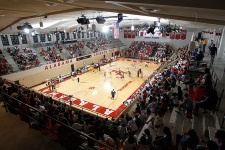 |
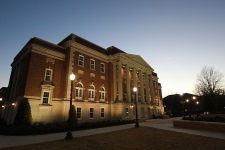 |
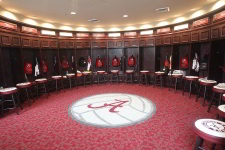 |
FOSTER AUDITORIUM
The University of Alabama Athletics Department renovated and expanded Foster Auditorium to create a new home for the Crimson Tide’s volleyball and women’s basketball programs in 2011.
“We are pleased to be able to renew and restore Foster Auditorium to its position as a vital hub of campus life,” Alabama Director of Athletics Mal Moore said. “Our volleyball and women’s basketball programs will have a tremendous arena to practice and play in that is located in the heart of campus.”
The restoration of the venerable three-story building was completed in January of 2011 in time for the women’s basketball game between Alabama and Florida on Feb. 13, when the Tide defeated the Gators 64-59.
The remodel of the facility included refurbishing the arena portion of the building with new seating both on the floor level and the second level which overlooks the court, creating an impressive competitive atmosphere for both sports.
“From the outside, Foster is a magnificent building,” head women’s volleyball coach Ed Allen said. “Once you get to the inside you see the quality at which the building was renovated, with the ability to create an intimate environment. Everything was done first class.”
The renovation also included suites for both programs that house the teams’ locker rooms, team areas, meeting and video rooms and coaches’ offices. A weight room and athletics training facilities were also included in the project.
“Foster Auditorium is one of the best volleyball facilities in the country,” Allen said. “It’s going to have a huge impact on our ability to attract the kind of athletes we expect to get at Alabama. For them to see the atmosphere they’re going to play in and how they are going to be taken care of makes the facility vital to our success. The fact that we don’t have to leave the arena to lift weights, practice or play will be enticing to future players at Alabama.”
Originally built in 1939, Foster Auditorium was named in 1942 for Richard Clarke Foster, president of the University of Alabama from 1937-41. It was the largest and most expensive of 14 buildings added to campus between 1936 and 1939 using funds from the Public Works Administration.
In its original capacity, Foster served as home for intramurals sports, graduations, concerts, lectures and campus meetings. It also served as the home of several varsity athletic programs over the years, including the men’s basketball team from 1939-68, women’s basketball, which played a few games in Foster in their inaugural season in 1975, and gymnastics from 1975-84.
In the early years of the Alabama’s volleyball program, the team practiced and competed in Foster. The women’s volleyball program, which began in 1974, played their first 15 seasons (1974-81 and 1989-95) in Foster Auditorium. The program was discontinued from 1982-88. The volleyball program made the move away from Foster before the 1996 season, playing in the main arena of Coleman Coliseum from 1996-99. Beginning with the 2000 campaign, volleyball competed in the Coleman Auxiliary Volleyball Extension (CAVE) to 11 seasons, before returning to Foster Auditorium in 2011.
Additionally, the women’s athletic program, including coaches and administrative offices, was located in Foster during the 1970s through the early 1980s.
Allen added, “Foster is going to create a lot of energy for the team and an atmosphere that fans will want to come back to. Playing in an intimate environment is going to be a huge home court advantage for us and it provides an opportunity to springboard the program. Additionally, it has all the bells and whistles that should help attract top-notch recruits. It was a huge selling point in my decision to come to Alabama.”
DIRECTIONS TO FOSTER AUDITORIUM
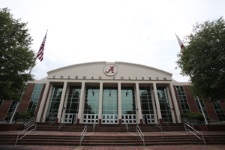 |
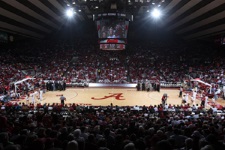 |
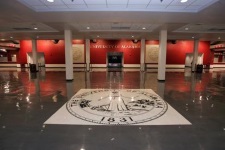 |
COLEMAN COLISEUM
The center of much of University of Alabama campus life since the facility opened in 1968, Coleman Coliseum is home to Alabama men's basketball.
Opened on January 30, 1968, and originally named Memorial Coliseum, Coleman Coliseum has served as the home court of the Alabama basketball team for 42 years.
One of college basketball's finest facilities then and now, the multi-purpose arena was ahead of its time when originally constructed at a cost of $4.2 million. The building occupies two acres of land with the roof reaching 90 feet above the playing surface and almost 100,000 square feet of space in the main seating area.
The arena was re-dedicated in 1988 as Coleman Coliseum in honor of Jeff Coleman, a long-time Crimson Tide historian, business manager for athletics and alumni director that served on the committee that oversaw construction and planning of the Coliseum.
The coliseum houses athletic department offices (except for football, swimming, rowing and men's tennis), the ticket and Tide Pride offices, a club level room (the Crimson Tide Room), a President's reception area (the C.M. Newton Room), an auxiliary gymnasium, an equipment room, weight rooms, steam bath, training room, food service areas, photo studios, and locker room facilities for staff and athletes.
Coleman Coliseum is underwent one of its biggest transformations in the first two seasons of Anthony Grant's tenure as new locker rooms and meeting areas for men's basketball were created within the existing structure. The expansion and renovation of the men's basketball facilities created an all-encompassing working space for the men's basketball program, connecting the main playing arena with the practice facility while establishing a first-class locker room, weight room, training room and team lounge.
DIRECTIONS TO COLEMAN COLISEUM
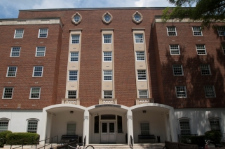 |
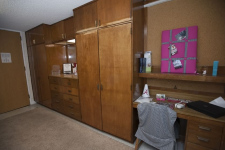 |
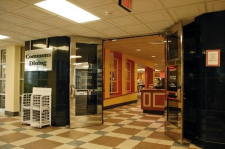 |
BURKE RESIDENCE HALL
Burke East and Burke West are coed by floor. Most rooms are double with community baths, although some suites are available. There is wireless internet access throughout the building.
Burke is on the southeast side of campus near Coleman Coliseum, Moody Music Building, the Quad and New Fraternity Row. Burke East and West remain open during university breaks.
DIRECTIONS TO BURKE RESIDENCE HALL
DIRECTIONS TO THE STUDENT RECREATION CENTER
